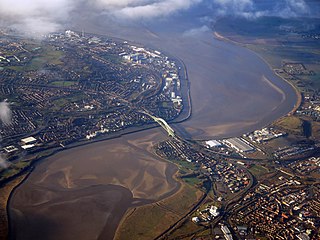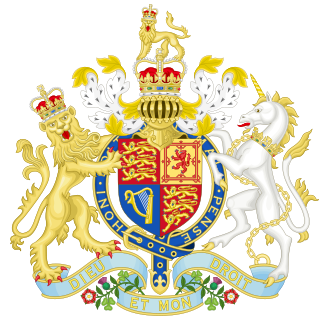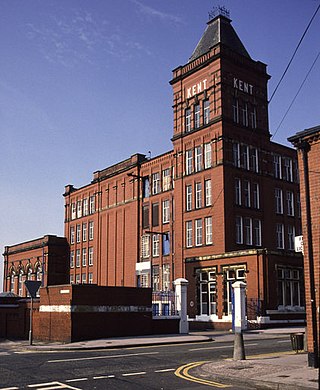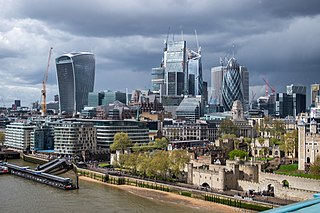Related Research Articles

The London Borough of Croydon is a London borough in south London, part of Outer London. It covers an area of 87 km2 (33.6 sq mi). It is the southernmost borough of London. At its centre is the historic town of Croydon from which the borough takes its name; while other urban centres include Coulsdon, Purley, South Norwood, Norbury, New Addington, Selsdon and Thornton Heath. Croydon is mentioned in Domesday Book, and from a small market town has expanded into one of the most populous areas on the fringe of London. The borough is now one of London's leading business, financial and cultural centres, and its influence in entertainment and the arts contribute to its status as a major metropolitan centre. Its population is 390,719, making it the most populous London borough and sixteenth largest English district.

The Greater London Council (GLC) was the top-tier local government administrative body for Greater London from 1965 to 1986. It replaced the earlier London County Council (LCC) which had covered a much smaller area. The GLC was dissolved in 1986 by the Local Government Act 1985 and its powers were devolved to the London boroughs and other entities. A new administrative body, known as the Greater London Authority (GLA), was established in 2000.

The Inner London Education Authority (ILEA) was the local education authority for the City of London and the 12 Inner London boroughs from 1965 until its abolition in 1990. From 1965 to 1986 it was an ad hoc committee of the Greater London Council; on 1 April 1986 it was reconstituted as a directly elected body corporate.

The Metropolitan Board of Works (MBW) was the upper tier of local government for London between 1856 and 1889, primarily responsible for upgrading infrastructure. It also had a parks and open spaces committee which set aside and opened up several landmark parks. The metropolis, which the board served, included substantial parts of Middlesex, Surrey, and Kent throughout the 33 years leading up to the advent of county councils. This urban zone lay around the medieval-sized City of London but plans to enact a similar body in 1837 failed. Parliament finally passed the Metropolis Management Act 1855 which dissolved a short-lived building office and a sewers commission and made the Board effective as of December that year. The board endured until it was succeeded by London County Council, as its directly elected, direct successor, in March 1889.

Taberner House housed many of the offices of Croydon London Borough Council until September 2013; the building was demolished in 2015. It was located in Croydon, London, close to the Croydon Town Hall.

Halton is a unitary authority area with borough status in the ceremonial county of Cheshire, North West England. The borough was created in 1974 and contains the towns of Runcorn and Widnes and the civil parishes of Daresbury, Hale, Halebank, Moore, Preston Brook, and Sandymoor. Since 1998, Halton Borough Council has been a unitary authority, being a district council which also performs the functions of a county council. Since 2014, it has been part of the Liverpool City Region and a member of the Liverpool City Region Combined Authority.

The functions of local government in the Republic of Ireland are mostly exercised by thirty-one local authorities, termed County, City, or City and County Councils. The principal decision-making body in each of the thirty-one local authorities is composed of the members of the council, elected by universal franchise in local elections every five years from multi-seat local electoral areas using the single transferable vote. Many of the authorities' statutory functions are, however, the responsibility of ministerially appointed career officials termed Chief executives. The competencies of the city and county councils include planning, transport infrastructure, sanitary services, public safety and the provision of public libraries. Each local authority sends representatives to one of three Regional Assemblies.

Coulsdon and Purley Urban District was a local government district in northeast Surrey from 1915 to 1965. The local authority was Coulsdon and Purley Urban District Council. The former area of the district is now mostly part of the London Borough of Croydon in Greater London, with parts in the Tandridge District and the Borough of Reigate and Banstead in Surrey.

Elections for the Croydon London Borough Council are held every four years to elect 70 councillors. The last ward boundary changes came into force at the 2018 local elections.

The London Government Act 1963 is an act of the Parliament of the United Kingdom, which created Greater London and a new local government structure within it. The Act significantly reduced the number of local government districts in the area, resulting in local authorities responsible for larger areas and populations. The upper tier of local government was reformed to cover the whole of the Greater London area and with a more strategic role; and the split of functions between upper and lower tiers was recast. The Act classified the boroughs into inner and outer London groups. The City of London and its corporation were essentially unreformed by the legislation. Subsequent amendments to the Act have significantly amended the upper tier arrangements, with the Greater London Council abolished in 1986, and the Greater London Authority introduced in 2000. As of 2024, the London boroughs are more or less identical to those created in 1965, although with some enhanced powers over services such as waste management and education.
Borough status is granted by royal charter to local government districts in England, Wales and Northern Ireland. The status is purely honorary, and does not give any additional powers to the council or inhabitants of the district. In Scotland, similarly chartered communities were known as royal burghs, although the status is no longer granted.

Taberner House housed many of the offices of Croydon London Borough Council until September 2013; the building was demolished in 2015. It was located in Croydon, London, close to the Croydon Town Hall.

Kent Mill, Chadderton was a cotton spinning mill in Chadderton, Oldham, Greater Manchester. It was built in 1908 for the Kent Mill Co. It was taken over by the Lancashire Cotton Corporation in 1938 and passed to Courtaulds in 1964. Production finished in 1991 and it was demolished in 1994.

Monton Mill was a cotton spinning mill in Eccles, Greater Manchester, England, built in 1906. It was taken over by the Lancashire Cotton Corporation in the 1930s and passed to Courtaulds in 1964. After production ended, it was demolished and replaced with housing; its name is preserved in the street name.

Orme Mill, Waterhead is a cotton spinning mill in Waterhead, Oldham, Greater Manchester, England. It was built in 1908. It was taken over by the Lancashire Cotton Corporation in the 1930s and production finished in 1960. The mill was passed on to Ferranti in 1964, and is now in multiple usage.

Croydon London Borough Council, which styles itself Croydon Council, is the local authority for the London Borough of Croydon in Greater London, England. It is a London borough council, one of 32 in London. Croydon is divided into 28 wards, electing 70 councillors. Since 2022 the council has been led by a directly elected mayor. The council has been under no overall control since 2022, being run by a Conservative minority administration. The council meets at Croydon Town Hall and has its main offices in the adjoining Bernard Weatherill House.
The Local Government Reform Act 2014 is an act of the Oireachtas which provided for a major restructuring of local government in Ireland with effect from the 2014 local elections. It merged some first-tier county and city councils, abolished all second-tier town and borough councils, and created a new second tier of municipal districts covering rural as well as urban areas. It also provided for a plebiscite on whether to create a directly elected executive Mayor of the Dublin Metropolitan Area although this provision was not activated. The act was introduced as a bill on 15 October 2013 by Phil Hogan, the Minister for the Environment, Community and Local Government, and signed into law on 27 January 2014 by President Michael D. Higgins. Most of its provisions came into force on 1 June 2014.
Healthcare in London, which consumes about a fifth of the NHS budget in England, is in many respects distinct from that in the rest of the United Kingdom, or England.

Greater London is an administrative area in England, coterminous with the London region, containing most of the continuous urban area of London. It contains 33 local government districts: the 32 London boroughs, which form a ceremonial county also called Greater London, and the City of London. The Greater London Authority is responsible for strategic local government across the region, and regular local government is the responsibility of the borough councils and the City of London Corporation. Greater London is bordered by the ceremonial counties of Hertfordshire to the north, Essex to the north-east, Kent to the south-east, Surrey to the south, and Berkshire and Buckinghamshire to the west.
References
- 1 2 Hatherley, Owen (22 December 2015). "Wouldn't buildings be better designed by people who lived in the city where they practiced?". Dezeen. Archived from the original on 6 July 2017. Retrieved 18 January 2018.
- ↑ Brook, Richard. "Roger Booth, Lancashire County Architect, 1962–83" (PDF). Manchester Metropolitan University. Retrieved 18 January 2018.
- ↑ "Papers relating to James Thomson, City Engineer, City Architect and Housing Director, Dundee – Archives Hub". University of Dundee. Archived from the original on 18 January 2018. Retrieved 18 January 2018.
- ↑ Goold, David. "Robert Thomson Morris". Dictionary of Scottish Architects -. Archived from the original on 18 January 2018. Retrieved 18 January 2018.
- ↑ "County Engineer and Surveyor's Department". The National Archives. Archived from the original on 2018-01-18.
- ↑ Spark, David; Harris, Geoffrey (2016). Practical Newspaper Reporting. CRC Press. p. 18. ISBN 9781136025389. Archived from the original on 18 January 2018. Retrieved 18 January 2018.
- ↑ "PA rejects extra floors for Valletta's Biċċerija quarter". Times of Malta. 13 July 2017. Archived from the original on 16 January 2018. Retrieved 10 January 2018.
- ↑ "€18 million development breathes new life into Limerick city centre". Limerick Post. 19 December 2017. Archived from the original on 16 January 2018. Retrieved 10 January 2018.
- 1 2 3 Lang, Ruth (17 January 2017). "In-house: the council architect". Architects' Journal. Archived from the original on 16 January 2018. Retrieved 9 January 2018.
- 1 2 3 Waite, Richard; MacKinnon, Ella (2 November 2015). "Which councils employ the most in-house architects?". Architects' Journal. Archived from the original on 16 January 2018. Retrieved 9 January 2018.
- 1 2 Marrs, Colin (28 October 2015). "Croydon creates first in-house architects department in years". Architects' Journal. Archived from the original on 16 January 2018. Retrieved 9 January 2018.